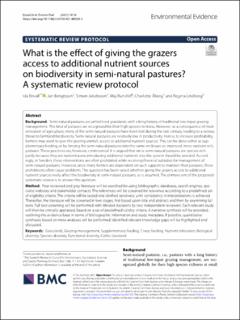What is the effect of giving the grazers access to additional nutrient sources on biodiversity in semi-natural pastures? A systematic review protocol
Peer reviewed, Journal article
Published version

Åpne
Permanent lenke
https://hdl.handle.net/11250/2987561Utgivelsesdato
2021Metadata
Vis full innførselSamlinger
- Publikasjoner fra CRIStin - NINA [2364]
- Scientific publications [1392]
Sammendrag
Sensors, such as accelerometers, in tracking devices allow for detailed bio-logging to understand animal behaviour, even in remote places where direct observation is difcult. To study breeding in birds remotely, one needs to understand how to recognise a breeding event from tracking data, and ideally validate this by direct observation. We tagged 49 adult female pink-footed geese (Anser brachyrhynchus) with transmitter neckbands in Finland in spring of 2018 and 2019, and in Svalbard in summer 2018, and validated inferences from tracking by feld observations of nesting sites and family status in 2018–2020 (54 spring–summer tracks). We estimated nesting locations by taking the median coordinates of GPS-fxes at which the goose was motionless (overall dynamic body acceleration, ODBA < 1) on days with a daily median ODBA < 1, which approached the real nesting locations closely (within 1.6–3.7 m, n = Background: Semi-natural pastures are unfertilized grasslands with a long history of traditional low-input grazing management. This kind of pastures are recognized for their high species richness. However, as a consequence of modernization of agriculture, many of the semi-natural pastures have been lost during the last century, leading to a serious threat to farmland biodiversity. Semi-natural pastures are relatively low in productivity. Hence, to increase proftability, farmers may want to give the grazing animals access to additional nutrient sources. This can be done either as supplementary feeding, or by fencing the semi-natural pastures into the same enclosure as improved, more nutrient-rich, pastures. These practices are, however, controversial. It is argued that since semi-natural pastures are species-rich partly because they are nutrient-poor, introducing additional nutrients into the system should be avoided. Accordingly, in Sweden, these interventions are often prohibited while receiving fnancial subsidies for management of semi-natural pastures. However, since many farmers are dependent on such support to maintain their pastures, these prohibitions often cause problems. The question has been raised whether giving the grazers access to additional nutrient sources really afect the biodiversity in semi-natural pastures, as is assumed. The primary aim of the proposed systematic review is to answer this question. Method: Peer-reviewed and grey literature will be searched for using bibliographic databases, search engines, specialist websites and stakeholder contacts. The references will be screened for relevance according to a predefned set of eligibility criteria. The criteria will be tested and clarifed iteratively, until consistency in interpretations is achieved. Thereafter, the literature will be screened in two stages, frst based upon title and abstract and then by examining full texts. Full text screening will be performed with blinded decisions by two independent reviewers. Each relevant study will then be critically appraised, based on a set of predefned validity criteria. A narrative synthesis will be provided, outlining the evidence base in terms of bibliographic information and study metadata. If possible, quantitative syntheses based on meta-analyses will be performed. Identifed relevant knowledge gaps will be highlighted and discussed. Grasslands, Grazing management, Supplementary feeding, Creep feeding, Nutrient relocation, Biological diversity, Species diversity, Functional diversity, Cattle, Livestock
